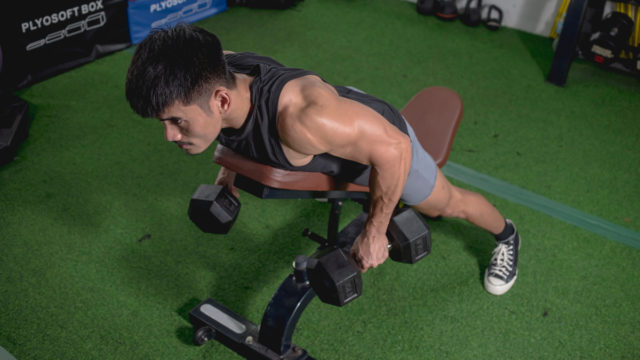
Although it isn’t one of the “mirror muscles” — body parts looking back in your reflection like the chest, shoulders, and arms — a well-developed back will balance your physique. A strong back will also improve functionality and aid performance in other exercises such as the bench press, deadlift, and shoulder press.
It’s easy to walk into the gym, plop down on any back machine, and haphazardly rep out on some hastily made piecemeal program. But if your goal is to get the absolute best out of your back training, then take a look at these four back workouts tailored to specific needs.
The Best Back Workouts
Best Back Workout for More Muscle
Adding muscle to your back will take plenty of volume and a rep range you’re most likely not used to. Hypertrophy training (growing muscle) requires recruiting the most muscle fibers, and then fatiguing those fibers so they’ll recover and adapt by growing larger in size.
While strength-focused training centers on using only a few compound exercises, training for more muscle size requires a variety of exercise angles so you can develop a complete back.
The Back-Building Workout
This plan is designed to add a maximum amount of muscle to your back. It’s not designed to move the maximum amount of weight. Using strict form during exercises is crucial.
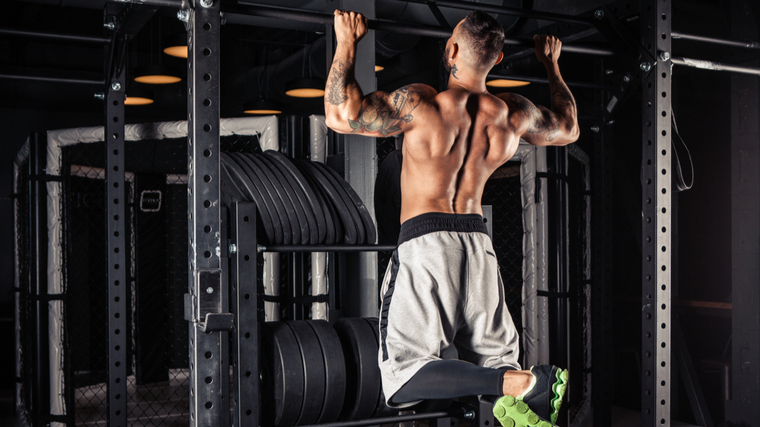
To stimulate the most muscle fibers and to shift the stress from your biceps onto your back, make sure you’re performing every rep with textbook form. Concentrate on squeezing your back by pulling with your elbows as opposed to pulling with your arms.
Wide-Grip Pull-up
- How to Do It: Grasp a pull-up bar with an overhand grip just outside of shoulder-width. Start the movement with slightly bent arms and take a big breath in. Pull your chest to the bar by arching your back slightly. Avoid swinging your legs. Lower under control.
- Sets and Reps: 30 total reps. Do as many sets as necessary.
- Rest Time: Two minutes between any sets.
Straight-Arm Cable Pulldown
- How to Do It: Stand in front of a high cable with a straight bar attached to the pulley. Take an overhand grip that’s slightly wider than your shoulders. Begin by pulling the handle down towards your pelvis. Do not bend your arms at any time. When the bar reaches your thighs, hold the contraction and squeeze for one second, and then slowly return to the starting position.
- Sets and Reps: 3 x 15
- Rest Time: One minute between sets.
Bent-Over Barbell Row
- How to Do It: Stand in front of the barbell with your feet shoulder-width apart. Bend at your hips, without rounding your back, until your upper body is nearly parallel with the floor. Grasp the bar with a palms-down, shoulder-width grip. Pull the weight up until the bar reaches near your belt-line. Keep a flat, not rounded, back through the entire rep. Return the weight down in a slow and controlled manner.
- Sets and Reps: 3 x 10-15
- Rest Time: One to two minutes between sets.
Close-Grip Pulldown
- How to Do It: Attach a narrow, parallel-grip handle to an overhead pulldown cable machine. With your hands facing each other, pull the weight straight down toward your chest. Keep your torso upright while slightly arching your back. Squeeze your shoulder blades together in the bottom position, and then return to the starting position with your arms overhead.
- Sets and Reps: 3 x 10-15
- Rest Time: One minute between sets.
Best Back Workout With Dumbbells
Not everyone has access to a fully stocked gym. Or some lifters just prefer to workout from home.They may also gravitate towards more dumbbell work for several reasons, including shoring up weaknesses on one side of the body.
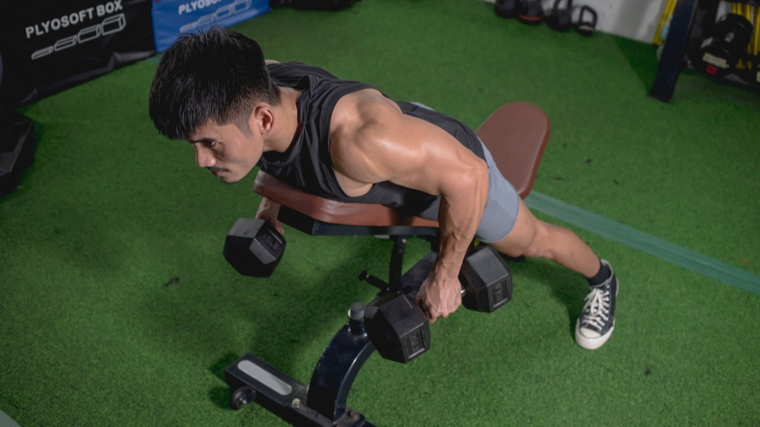

If you fit into one of these categories, all you need to develop a great back is several pairs of dumbbells — or one adjustable pair — and a bench. With a little creativity and fortitude, you can easily build an effective back routine with minimal equipment.
The Dumbbell Back Workout
Don’t be fooled into thinking you “need” a heavy barbell, pulldown station, row machine, and chin-up bar to train your back. Done correctly, an all-dumbbell workout can still be just as effective as any multi-equipment program. As long as you pay especially close attention to form and function, you’ll get all the results.
Cross-Bench Dumbbell Pullover
- How to Do It: Lie perpendicular on a flat bench, with only your upper back touching the pad. Your abdomen and head should be hanging over either side of the bench. Plant your feet and bend your legs to hold a straight line from your head to your knees. Grasp a dumbbell with interlocked hands flat against the weight, supporting the weight above your chest. Keep a slight bend in your arms throughout the entire rep. Lower the weight in an arc backwards behind your head while taking a deep breath. Feel your lats stretch as you near the bottom of the movement. Reverse the motion to pull the weight upwards along the same arc while exhaling.
- Sets and Reps: 3 x 12
- Rest Time: One minute between sets.
Chest-Supported Dumbbell Row
- How to Do It: Set an adjustable bench to a low angle (roughly 30 degrees). Lie face down on the bench with your chest resting on the pad. Take a pair of dumbbells with your hands facing each other. Row both weights to your waist without raising your upper body off the bench. Squeeze at the top before returning to the stretched position.
- Sets and Reps: 3 x 10-15
- Rest Time: One minute between sets.
Single-Arm Dumbbell Row
- How to Do It: Grab a dumbbell with one hand and bend at the hips, keeping your feet roughly shoulder-width apart. Place your free hand on a solid surface, like a flat bench, for support. Avoid rounding your back. Pull the dumbbell towards your waistline without twisting your back. Maintain a stable spine position throughout the movement. Squeeze your back at the top and lower the weight under control.
- Sets and Reps: 3 x 8-10
- Rest Time: No rest between sides.
Best Back Workout for Beginners
If you’re new to the iron game, you’ll need to perfect your form from the beginning. Overcomplicated programs will only leave you frustrated, and potentially injured, if you don’t have the basics covered.
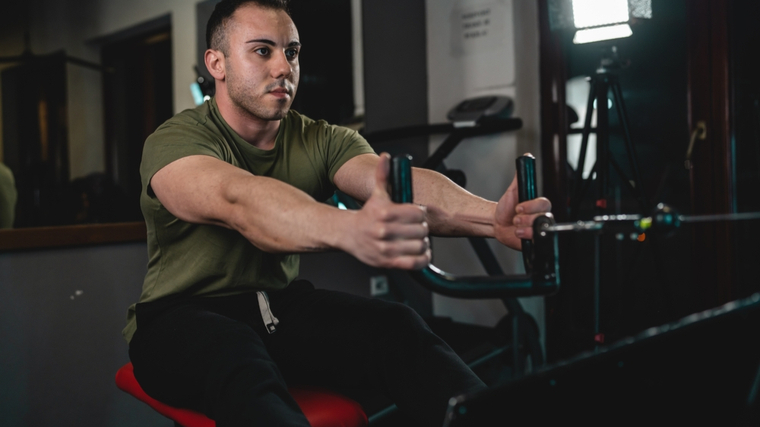

This routine prioritizes basic movements for the back and builds an initial foundation of strength.
The Back to Basics Workout
Working with your bodyweight and making each side of the body work in unison will ensure you develop a base of strength without needing an assortment of machines or advanced techniques. Perform this workout twice per week for at least eight weeks before incorporating more advanced exercises.
Chin-up
- How to Do It: Grasp a pull up bar with an underhand, shoulder-width grip. Pull your body upwards, leading with your chest. Your elbows should trail past your sides as you move up. Lower yourself slowly. Keep a slight bend in your elbows in the bottom position.
- Sets and Reps: 30 reps total. Do as many sets as necessary.
- Rest Time: Two minutes between any sets.
Two-Arm Dumbbell Row
- How to Do It: Bend at your hips until your torso is nearly parallel to the floor. Grasp a pair of dumbbells with a neutral grip (palms facing each other). Pull both weights up to the sides of your abs. Focus on feeling your lats contract during the movement. Lower both weights under control.
- Sets and Reps: 3 x 12
- Rest Time: One minute between sets.
Close-Grip Pulley Row
- How to Do It: Attach a close-grip parallel handle on a pulley row machine. Sit with your knees slightly bent. Begin with your torso leaning slightly forward and feel a stretch in your lats. Pull the handle towards your stomach as you straighten your spine and sit upright. In the contracted position, squeeze your shoulder blades together. Reverse the motion and return the weight forward under control.
- Sets and Reps: 3 x 12
- Rest Time: One minute between sets.
Best Back Workout for Strength
Training to build sheer strength is a different animal. Being performance-based, as opposed to being visually based, pure strength training is all about pushing more weight for more reps. However, you still need to execute good form. Heaving, swaying, and cheating the weight up just for the sake of extra reps or more weight will only lead to injury.
The Workout for a Strong Back
This workout can be performed once or twice per week. Because it is strength-focused, it utilizes big, multi-joint lifts enabling you to lift heavier loads. That’s not an excuse to let your ego call the shots — lift only what you can with solid form within the prescribed rep range.


Increase only when you’re comfortably handling the current load for the target reps. Add weight in small increments and always practice good form.
Weighted Wide-Grip Pull-up
- How to Do It: Perform the basic wide-grip pull-up as explained earlier, only this time you’ll be hanging a weight belt around your waist. Perform controlled reps without swinging your body. The added weight can strain your shoulders if you allow your form to get loose, so focus on staying tight throughout the rep.
- Sets and Reps: 3 x 4-6
- Rest Time: Two to three minutes between sets.
Deadlift
- How to Do It: Place a loaded barbell on the floor. Keep a flat back and squat down to reach the bar. Take an overhand grip just outside your knees. Begin the lift by pulling the bar up along your shins while keeping your back straight and your head up. Keep the bar in contact with your thighs as you stand up. Keep your spine straight throughout the motion. Avoid locking your knees at the top. Return the bar to the floor by reversing the motion.
- Sets and Reps: 5 x 4-6
- Rest Time: Three to five minutes between sets.
Pendlay Row
- How to Do It: The Pendlay row is performed much like the traditional bent-over barbell row (explained earlier) with one distinct difference. Every time you lower the weight, allow the bar to completely rest on the floor for a second before starting your next rep. This enables you to regroup your strength with a very short rest in between each individual rep.
- Sets and Reps: 4 x 6-8
- Rest Time: Three minutes between sets.
Muscles of the Back
The back is, overall, one of the largest muscle groups on the body. This is why building a more muscular back can dramatically change your overall appearance and strength.
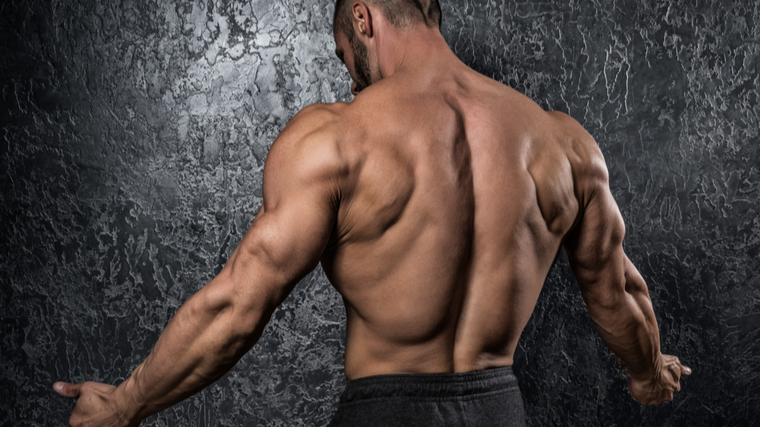

The multiple muscles that cover the back are the reason why multiple exercises and multiple angles are necessary for complete development.
Latissimus Dorsi
The latissimus are the “wing-like” muscles on both sides of your back that give a wide appearance. Your lats function to extend and rotate your upper arm, during pulldowns, pull-ups, and rows.
Additionally, they stabilize the lower back when your arm is in a fixed position, such as during a deadlift.
Trapezius
The trapezius are the meaty muscles on either side of your neck. They also run from shoulder to shoulder on your back and partially cover your shoulder blades.
Your traps not only elevate your shoulders (in the classic shrug motion), they also function to retract your shoulders by pulling them back. When your shoulder blades are “pinched” together, the lower portion of the traps are highly activated.
Rhomboids
The rhomboids are relatively smaller, but no less important, muscles found on your upper back. They connect to the scapulae (shoulder blades) and primarily function to retract and stabilize your shoulder blades when your arms move.
Erector Spinae
The erector spinae, or spinal erectors, are a pair of symmetrical muscles running in a long column along the length of your spine.
They work to extend your spine (bending backwards) and they resist spinal flexion (bending forward). This is a major reason why rounding your back during weighted exercises can cause injury — when the load is beyond the erectors’ ability to prevent flexion. The erectors also laterally flex your trunk when acting on one side only, seen when holding a heavy weight in one hand.
How to Warm-Up Your Back
The back is a large muscle group requiring a comprehensive warm-up prior to your primary training routine. Warming up not only prepares each muscle for the work to come, it also increases blood flow to the overall area.
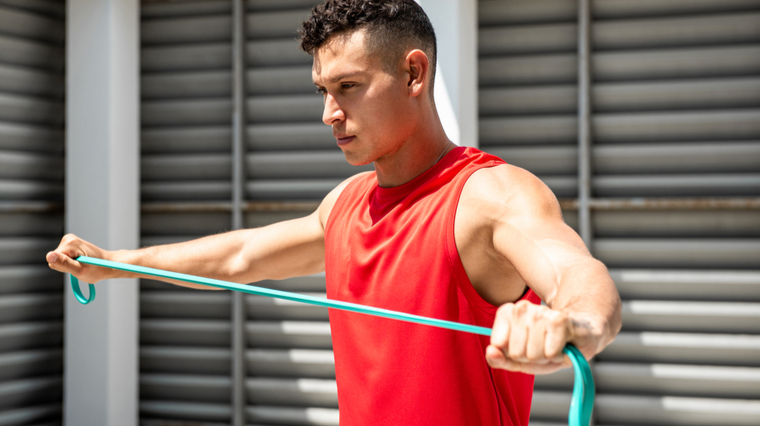

A good warm-up also primes your nervous system to stimulate muscle fiber contractions more efficiently, leading to more power and strength.
A Top to Bottom Back Warm-Up
- Lat Pulldown: Take a wide-grip at a basic pulldown station. Perform reps with a full range of motion, contracting the back in the bottom position and achieving a full stretch at the top. Perform two sets of 15 reps.
- Band Pull-Apart: Stand with your arms extended in front of your chest, with a palms-down grip on a resistance band. Keep a slight bend in your arms while pulling the band apart until it touches your chest. Hold for one second before reversing the motion under control. Perform two sets of 15 reps.
- Hyperextension: Lie face down on a back hyperextension machine with the pads on your hips. Lean forward and lower your upper body into a stretched position. Return upright to hold a straight line from your ankles to your shoulders. Perform two sets of 8 reps.
- Bent-Over Lateral Raise: Stand with your feet wider than shoulder-width, while holding a pair of light dumbbells. Bend forward at the waist, allowing the weights to extend down. Keep your back straight and maintain a slight bend in your arms. Raise both weights until your elbows are in line with your shoulders and then lower both under control. Perform two sets of 8 reps.
Attack the Back
There are several ways to build muscle and strength in your back whether it’s for building muscle, developing more strength, a dumbbell only workout, or even if you’re a beginner. No matter your goal, a comprehensive plan is a must when it comes to the complexities of the back. Try some of the workouts above and watch your back grow stronger, bigger, and more muscular than ever before.
Featured Image: MDV Edwards / Shutterstock






